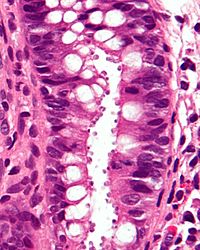
Photo from wikipedia
Giardia, Cryptosporidium, Cyclospora, and microsporidia are gastrointestinal pathogens that can cause various disease symptoms in both animals and humans. Numerous studies worldwide have confirmed the presence of these eukaryotic pathogens… Click to show full abstract
Giardia, Cryptosporidium, Cyclospora, and microsporidia are gastrointestinal pathogens that can cause various disease symptoms in both animals and humans. Numerous studies worldwide have confirmed the presence of these eukaryotic pathogens in nesting and migrating wild geese, ducks, and swans. Migration spreads these zoonotic enteric pathogens to distant locations, which could have public health implications. Soils and water bodies (lakes, ponds, rivers and wetlands) in urban and suburban areas have been shown to be vulnerable to contamination by waterfowl droppings. This review addresses the epidemiology of these enteric pathogens in wild migratory bird species (Anatidae) and some consequences of their spread in the environment. To date, both zoonotic pathogens and genotypes restricted to avian hosts have been found in faecal samples from 21 anatid species worldwide. One of the routes of infection for these zoonotic gastrointestinal micropathogens is the indirect route. For example, shared water bodies (e.g., for drinking or recreational purposes) previously contaminated by birds during the migratory season may facilitate infections of humans through water. However, it is unclear how much wild waterfowl contribute to the transmission of giardiasis, cryptosporidiosis, cyclosporosis, and microsporidiosis in many regions through contaminated environmental sources. Comprehensive epidemiological surveillance based on molecular data on gastrointestinal pathogens is crucial to take measures to control infections in the future.
Journal Title: Pathogens
Year Published: 2023
Link to full text (if available)
Share on Social Media: Sign Up to like & get
recommendations!